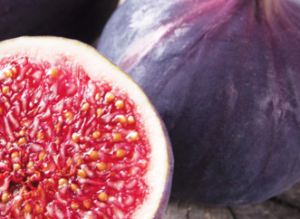 Fig season in California starts mid-May and runs through October. Delicate, delicious, and extremely perishable, fresh figs are best eaten within a few days of procurement, but can be stored in the refrigerator on a plate under paper towels for two to three days.
Fig season in California starts mid-May and runs through October. Delicate, delicious, and extremely perishable, fresh figs are best eaten within a few days of procurement, but can be stored in the refrigerator on a plate under paper towels for two to three days.
According to The Encyclopedia of Healing Foods by Michael Murray, figs are naturally rich in potassium, calcium, magnesium, iron, copper and manganese; four to five figs contain just about 150 calories. Because of their high potassium content, they are considered helpful for regulating blood pressure. Additionally, they are among the most highly alkaline foods so they help support the body’s pH balance. Author Paul Pitchford discusses this in his book, Healing with Whole Foods—Asian Traditions and Modern Nutrition, where he states that figs balance acidic conditions resulting from a diet rich in meat and refined foods. Further, as a toxin neutralizer, figs facilitate healing and ease seasonal transitions, such as the current transition to summer.
An early symbol of peace and prosperity, eating figs may help pacify digestive distress such as dysentery, constipation, and hemorrhoids.
Figs originally came to California via southern Europe and the Middle East by way of the Spanish missionaries, hence the commonly found “Mission fig” with purplish-black skin and pink flesh. More than 100 varieties exist, ranging in size and color from the larger Calimyrna with greenish-yellow skin and amber flesh to the smaller Adriatic with light green skin and pink flesh, and the Brown Turkey with purple skin and red flesh. Note that the chewy skin, delicate flesh, and crunchy seeds are all edible, so just eat the whole thing (except the stem, of course).
While fresh figs are just fantastic on their own, consider:
• Slathering them with almond butter for a simple breakfast.
• Finely chopping and then rolling them into a gluten-free tortilla, slicing it crosswise, and baking until figs begin to melt and tortilla becomes brown and crunchy.
• Simply scattering them around a cheese plate with almonds and walnuts.
• Slicing them in half and drizzling with balsamic and grated Manchego cheese (a Spanish sheep’s milk cheese) in this Spanish take on what I think of as a baked cheese plate:
Manchego Baked Figs
Prep Time: 5 minutes
Cook Time: 8-10 minutes
Yield: 8 servings
Ingredients:
1 pint fresh figs – green Adriatic, black Mission figs, or a combination
1 or 2 tbsp balsamic vinegar* (good quality—aged in wood barrels at least four years or labeled balsamic vinegar or Modena)
Fresh black pepper
4 oz. Manchego cheese
Directions:
1. Preheat oven to 350 degrees.
2. Cut the figs in half lengthwise with a serrated or sharp paring knife (it may be helpful to dip your knife into hot water between slices so as to manage the stickiness). Place onto a baking sheet, cut side up.
3. Drizzle lightly with balsamic vinegar and crack some fresh black pepper over the top. Grate the cheese atop the figs.
4. Bake for 8-10 minutes or until cheese is melting and just beginning to brown (when you smell the nutty Manchego wafting from the oven, it’s just about done). Serve hot or warm.
Notes:
It’s true that recipes with these few ingredients are simple, but it’s the quality of the ingredients that make this dish simply delicious! This is the place to showcase great fruit, cheese, and your best quality balsamic.
Red Jen Ford is a certified holistic health coach, yoga instructor, and seasonal eating expert. Jen teaches about the benefits and simplicity of eating local, sustainably-grown food. Enjoy more of her dishes in her seasonal recipe booklets or online course, Simply in Season – Fall Recipes to Celebrate Healthy, Easy Seasonal Food.
Red Jen Ford is a Certified Holistic Health Coach, Yoga Instructor and Seasonal Eating Expert. Jen teaches her clients the benefits and simplicity of eating local, sustainably grown food. Enjoy more of her dishes in her seasonal recipe booklets or her online course, Simply in Season: Recipes to Celebrate Healthy, Easy Seasonal Food.
